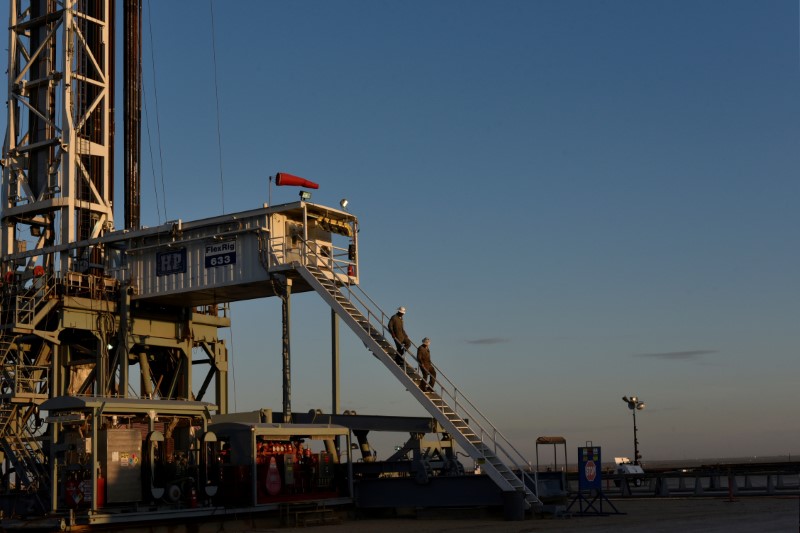By Jennifer Hiller and Devika Krishna Kumar
HOUSTON/NEW YORK (Reuters) - U.S. shale oil producers are beginning to reverse production cuts as prices recover from historic lows, underscoring shale's ability to quickly adjust to pricing and posing a challenge to OPEC as it considers extending production curbs.
U.S. producers slashed output in April and May as oil prices collapsed due to a supply glut and as restrictions on populations worldwide to slow the COVID-19 pandemic destroyed fuel demand.
Shale producers Parsley Energy Inc (N:PE) and EOG Resources Inc (N:EOG) on Tuesday disclosed plans to restore some or all of their output cuts. In North Dakota, state energy officials this week reduced by 7% an estimate of production shut-ins in the second-largest oil producing state.
Production coming back online is a fraction of what has been cut. Still, returning shale output may complicate deliberations among the Organization of the Petroleum Exporting Countries (OPEC) and allies when they meet on Thursday to consider extending an agreement to cut a record 9.7 million barrels per day (bpd) to offset the lost demand from the coronavirus outbreak.
Unlike OPEC and its allies, shale producers do not participate in government-mandated production cuts. They cut their output only when prices make pumping oil unprofitable.
For most shale producers, current prices are not enough to turn a profit on new wells, and U.S. oil companies are forecast to pare their output by as much as 2 million bpd this year.
Parsley plans to restore all of the 26,000 bpd it cut this spring and an EOG Resources executive told investors on Tuesday at an RBC Capital Markets conference it would reopen shuttered wells and add new ones in the second half of the year.
EOG, one of the largest U.S. shale producers which last year had more than 450,000 bpd of output, starting next month will open wells it had curtailed and "bring on wells that we've completed and not turned on yet," said Kenneth Boedeker, EOG's head of exploration and production.
OIL SPENDING REMAINS DEPRESSED
Analysts are easing estimates of overall U.S. production cuts, which have ranged up to 2 million bpd by December. Oil firms reduced planned spending on production this year by an average of a third, leading to output and job cuts across the energy sector.
Consultancy Rystad Energy estimates U.S. production will pare 1.3 million to 1.35 million bpd in June, down from the 1.65 million bpd cut it had initially expected.
"Many larger producers might restore significant part of curtailed production" in June, said Artem Abramov, Rystad's head of shale research.
While producers recently have begun fielding calls from exporters for additional supplies, the new demand is modest and still rare, said a trader at a global oil merchant who could not be identified because he was not authorized to speak to the media.
"The ones who are proposing to go fully back are generally really small producers with a minimal impact on overall supply," the person said.
NOT DRILLING NEW WELLS
U.S. crude futures (CLc1) on Tuesday ended the session at $36.81 a barrel, up about $16 from a month ago.
But prices for later months are trading higher than nearby months and producers can lock in sales at those prices. U.S. crude prices for August
"... we see demand coming up, and we think that sets us up for increased prices," EOG's Boedeker said.
"We are not putting new capital to work," Parsley Chief Executive Matt Gallagher told Reuters. The company's reversal of production cuts does not mean it will drill new wells "as we evaluate market fundamentals."
Phillip Gobe, CEO of ProPetro Holding Corp (N:PUMP), a services firm that fracks shale wells, told investors on Tuesday not to read too much into any pickup in fracking activity because pricing remains depressed.
"Activity could pick up," said Gobe in a conference call, "but it may not be profitable activity, it may not be cost-effective activity."
